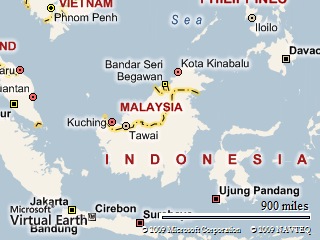
Bornean Bay Cat – Photograph copyright Jim Sanderson, Ph.D – Please respect copyright.
Below is a cleaned up and labelled version (this page has been upgraded on 4th July 2018):

Introduction
The “bay cat” is the world’s least know cat (felid). It is only found on the island of Borneo and that island is being logged relentlessly which is unfortunate for the bay cat as it lives in dense forest. It is very rare and becoming rarer.
The first bay cat was collected in 1855 by Alfred Wallace. I think it is in the British Museum. By 1928 there were 8 skins from this cat but no live cats. In Nov 1992 the first love bay cat surfaced caught by trappers on the Sarawak-Indonesia border. The cat was female and near death because she had been held captive for months trying to find someone to handle it.
Size
The bay cat is about the size of domestic cats and looks like a smaller Asiatic golden cat. The cat has 2 colour phases. The coat can be mahogany red or blackish gray with paler underparts and faint spots on the belly and limbs.
Overview
As can be seen this cat is medium sized and quite rangy making it probably a good jumper, which is to be expected living in the dense tropical forests of Borneo and found up to an altitude of about 900 metres.
The early years of its discovery are interesting. This is the world’s least known felid, it is said.
The IUCN Red List for Threatened Species™ says that this cat has never been studied and as a consequence there is no information on diet. Although it probably feeds on small animals such as rodents, frogs, birds and also carrion. This cat is not, it seems, crepuscular (main activity at dawn, dusk and night) as camera traps have photographed activity during the day and night. It has an appearance that is somewhat unusual.
As the virgin forests of Borneo are being extensively logged its habitat and prey is diminishing in size and numbers and as a consequence its existence in the wild is threatened. There are probably none in captivity.
Name
The Borneo Bay Cat has several other names in the English language, all of which are acceptable to the IUCN:
- Borneo Bay Cat
- Bay Cat
- Bornean Bay Cat
- Bornean Marbled Cat
Plus:
- Chat Bai (French)
- Gato Rojo De Borneo (Spanish)
All the above are listed on the IUCN Red List for Threatened Species™ website. The other names for this cat (including names in other languages) not listed on the IUCN Red List for Threatened Species™ website are:
- Borneo-katze
- Kucing Kalimantan
- Kucing Merahor
That makes 9 different names. There is only one scientific name, however: Pardofelis badia. The Bornean Bay Cat is placed in the genus Pardofelis with the Asiatic Golden Cat (also called the Asian Golden Cat). At one time it was thought that this wild cat species was an island form of the Asiatic Golden Cat but it is now thought that both have a common ancestor making this cat a unique species. The Bay Cat and Asiatic Golden Cat diverged, it is thought, from the common ancestor some 4.9-5.3 million years ago well before the island of Borneo was created about 10,000-15,000 years ago.
This medium sized wild cat is, as you guessed, found in Borneo:

Borneo is the island in the middle of the map.


The most important thing about the Bornean bay cat is that its habitat is being chopped down for photocopying paper! It is very sad.
Would like to know why so is little-known about this car and why no one has tried to find out more about it? I would love to read more on this cat.